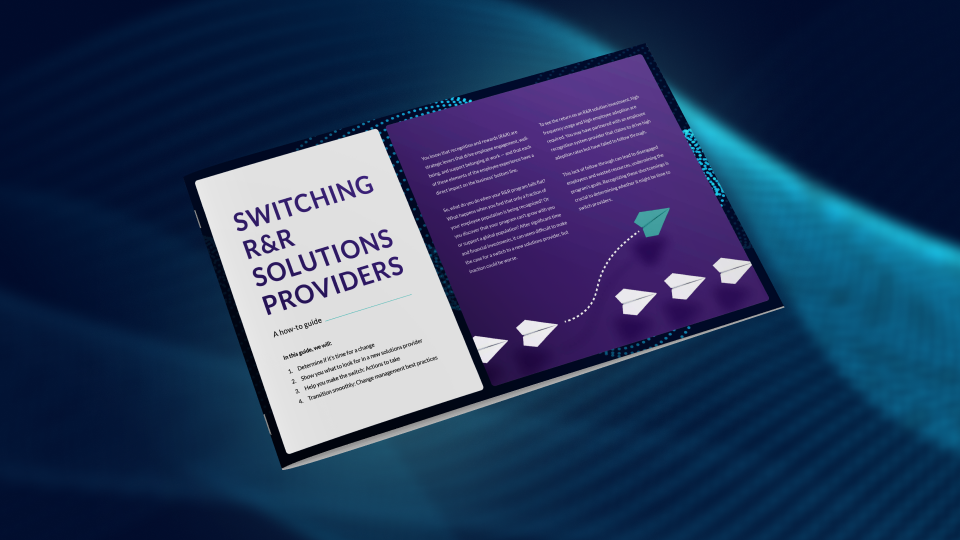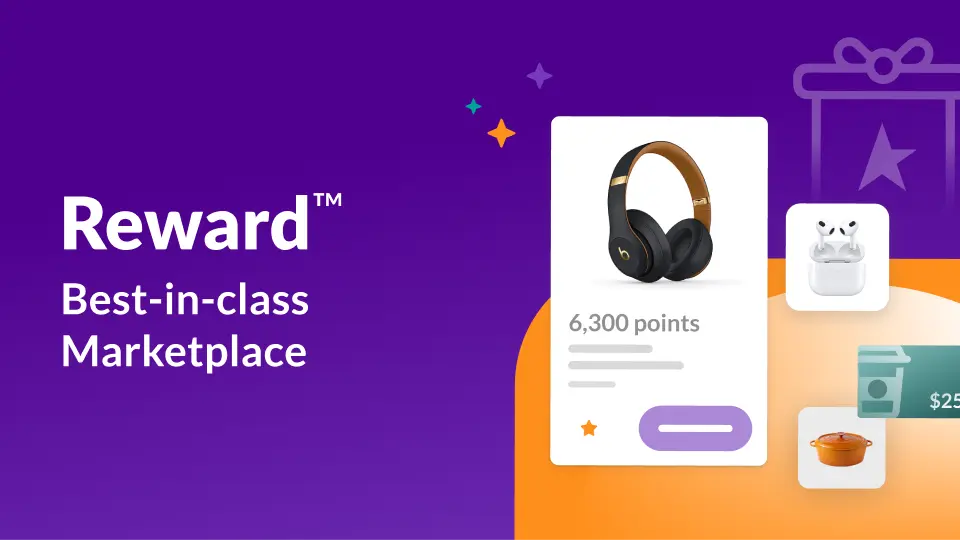Table of contents
What makes employees excited to stay and give their best every day? A total rewards program that goes beyond a paycheck can make all the difference. When companies provide meaningful recognition, career growth, and well-being support, employees feel valued and motivated.
In fact, organizations with strong recognition programs see 31% lower voluntary turnover, proving that rewards drive retention and engagement. But building a total rewards program that truly stands out takes more than just a few perks. It requires a thoughtful approach that balances compensation, benefits, recognition, and growth opportunities.
So, how do you create a total rewards program that not only meets employee expectations but excites and inspires them? In this guide, we’ll break down the essential elements, share best practices, and help you build a rewards strategy that keeps employees engaged and invested.
What are total rewards?
Total rewards refer to the complete package of compensation, benefits, and workplace experiences that an organization provides to its employees. This concept extends beyond salary to include perks like healthcare, professional development opportunities, recognition programs, and initiatives that support well-being. A strong total rewards approach ensures employees feel valued, motivated, and invested in their roles, contributing to higher engagement and retention.
What are total rewards programs?
Total rewards programs are structured frameworks that organizations use to deliver a mix of compensation, benefits, and engagement initiatives. These programs are designed to create a compelling employee experience by combining salary, incentives, recognition, career growth opportunities, and well-being support. By implementing an effective total rewards program, companies can attract top talent, enhance job satisfaction, and cultivate a thriving workplace culture.
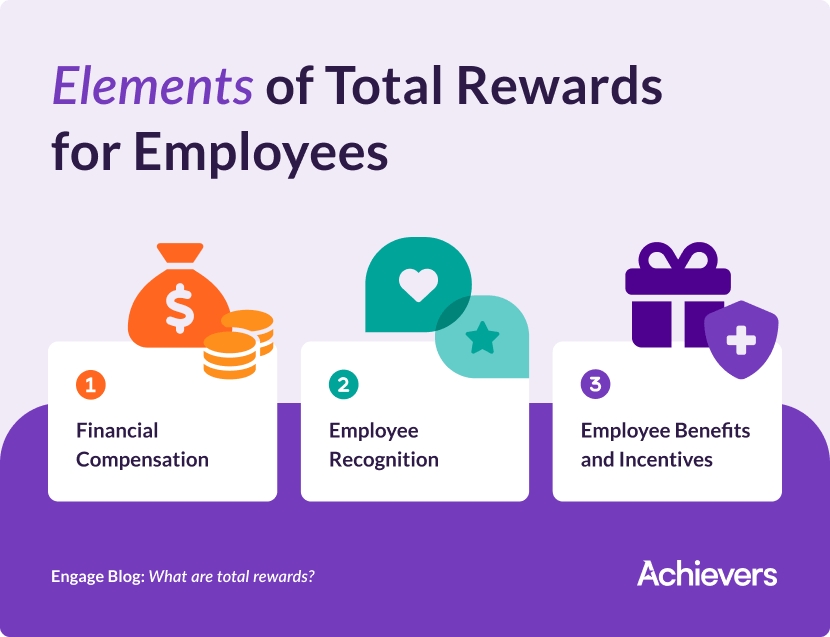
The key elements of total rewards programs for employees
Total rewards programs encompass financial compensation, healthcare benefits, time off, recognition programs, and more. Let’s explore the key elements of a total rewards package and why each plays a crucial role in the bigger picture:
1. Financial compensation
Financial compensation isn’t the be-all and end-all of incentivizing employees, but it’s still a key part of an organization’s total rewards offerings. Think of it as the foundation for an effective total rewards strategy. If you offer a tantalizing array of benefits but neglect to provide competitive compensation, you’ve undermined your company’s entire total rewards package.
Examples of financial compensation
- Salary
- Bonuses
- Commissions
- Stock options
2. Employee recognition
Employee recognition is about making people feel seen, valued, and motivated to do their best work. While financial rewards like gift cards and bonuses matter, frequent social recognition can have an even bigger impact, boosting morale, performance, and even company success. A culture of recognition doesn’t happen by accident — it starts when everyone, from leadership to entry-level employees, makes appreciation a habit.
Examples of employee recognition
- Public shoutouts
- Recognition posts on social media
- Personalized e-cards or messages
- Employee recognition platforms
3. Employee benefits and incentives
Employee incentives include health and retirement benefits, gym and wellness plans, flexible work arrangements, paid time off, tuition reimbursement, and much more. These days, employees expect an outstanding array of benefits, so your organization should implement a variety of strategic employee incentive programs. Unique benefits such as referral programs, the ability for employees to choose from among a set of projects, and talent development initiatives help your company stand out from the competition.
Examples of employee benefits and incentives
- Health benefits
- Retirement benefits
- Wellness plans
- Paid time off
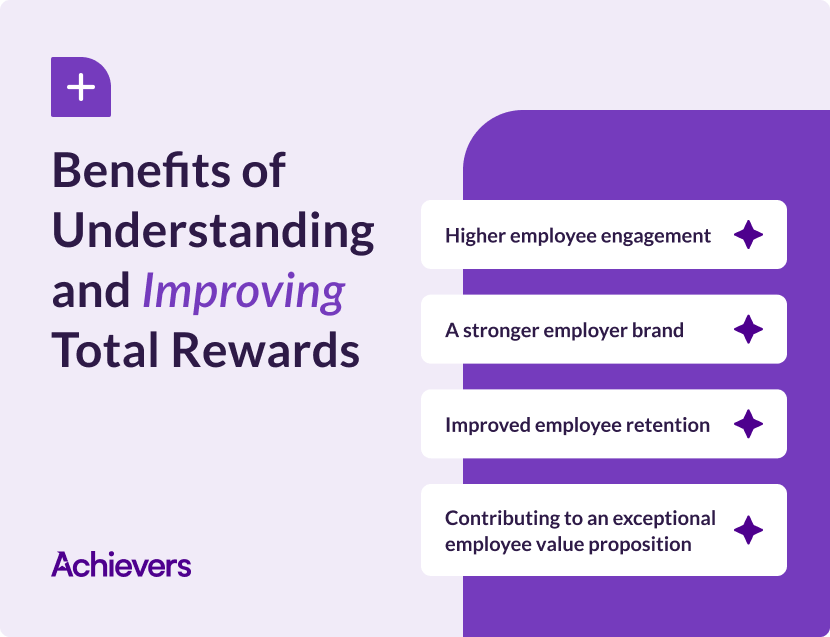
The benefits of understanding and improving total rewards
Incorporating the concept of total rewards into your organizational culture and developing an exceptional suite of rewards doesn’t happen overnight. But the time and effort it takes to evaluate and improve your organization’s offerings pays dividends in the long run. Here are just some of the ways your organization stands to gain:
- Higher employee engagement: When employees feel valued, they put in more effort. A strong total rewards program boosts motivation and engagement by recognizing contributions in meaningful ways. In fact, employee recognition is the biggest driver of engagement, making it a crucial part of any rewards strategy. When companies prioritize appreciation, employees are more likely to stay committed and perform at their best.
- A stronger employer brand: A great employer brand attracts top talent, and a standout total rewards program helps build it. Candidates want to work for companies that treat employees well — something they hear about from friends, colleagues, or online reviews. When employees rave about their benefits, recognition, and growth opportunities, more candidates become eager to join the team.
- Improved employee retention: Retaining employees is a challenge, but a well-structured total rewards program makes it easier. Offering incentives that competitors can’t match gives employees a compelling reason to stay. Plus, when companies actively educate employees about their rewards and perks, participation increases, strengthening loyalty and reducing turnover.
- Contributing to an exceptional employee value proposition: A company’s employee value proposition (EVP) reflects what it offers team members, from culture to benefits. A strong total rewards package plays a key role in making an EVP stand out. Without competitive perks, an organization may struggle to attract and retain talent. By aligning rewards with employee priorities, companies can enhance their EVP, making their workplace a more desirable choice.
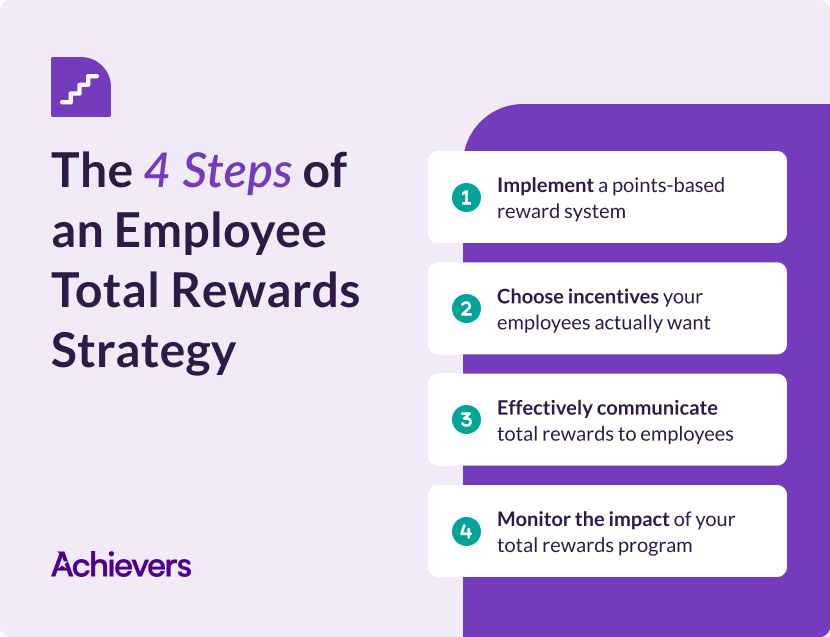
4 steps to building a winning total rewards strategy
Ready to launch or revamp a total rewards strategy at your organization? Follow the four steps below, and you’ll be on your way to an impactful total rewards program in no time:
1. Implement a points-based reward system
The appreciation employees receive at your organization, whether from their peers, leadership, or the company itself, is one of the most critical components of a total rewards package. The most impactful employee recognition programs empower all team members to easily provide and receive both social and monetary recognition — and the easiest way to get there at your company is with an employee recognition platform that supports points-based rewards.
With this system, all employees gradually accrue points that they can award to others whenever they send a message of thanks to another team member. Whenever the recipient has amassed enough points, they can redeem them for something that they actually find exciting from a wide-ranging catalog of rewards. This simple, effective system encourages all team members to frequently show appreciation to others by making recognition an engaging, fun, and mutually rewarding experience.
2. Choose incentives your employees actually want
The best incentives in the world won’t matter if your employees aren’t interested in them. To ensure the benefits your company offers are things your employees value, research the range of incentives modern companies can offer, and then determine which team members want most. Don’t simply schedule a series of meetings with employees to ask them about current and potential incentives, though. The answers you get are unlikely to be completely honest, and you can’t continually gather up-to-date information with the occasional meeting either.
Instead, the best way to get honest input from employees on this critical topic is by collecting real-time feedback anonymously with the help of an employee engagement platform. Using pulse surveys and always-on feedback channels, your company can effectively align its total reward offerings with employee preferences both now and in the future.
3. Effectively communicate total rewards to employees
The whole point of having total rewards is for employees to take advantage of them — but they can’t do that if they don’t know what programs exist. Build a total rewards communication strategy that includes describing total rewards when an employee onboards to your company and providing statements for employees to remind them of incentives they may have forgotten.
While crafting personalized statements for each team member, organize different types of total rewards to make the list easy to parse. And keep your value estimates for each reward realistic, so employees don’t feel that your company is exaggerating how much certain offerings are worth. After the statements are complete, provide them to employees confidentially on an annual basis, either through a secure digital channel or in-person during a 1-on-1 meeting with the employee’s manager.
4. Monitor the impact of your total rewards program
Total rewards programs shouldn’t be one-and-done projects. Continually collecting honest employee input and making adjustments to your total rewards offerings reinforces your commitment to your employees and maximizes the impact total rewards can have on their well-being and output. Of course, simply collecting information is not enough. Analyzing feedback and turning insights into action is perhaps the most essential aspect of continuous improvement.
Developing and executing solid action plans shows your employees that their voices are being heard and helps your organization make the most of its total rewards budget. For instance, if your latest pulse survey shows that employees want more recognition, and internal data suggests that few are utilizing the free gym memberships your organization offers, it may be time to put more of your dollars behind an employee recognition program. Or if employees feel that the biggest contributors at your company are underappreciated, set aside some funding for monthly employee awards to highlight all the ways team members contribute to your organization.
Take your total rewards program to the next level
Building a total rewards program that excites and engages employees requires more than just offering competitive salaries and benefits — it’s about fostering a culture of appreciation, growth, and well-being.
Achievers makes this easy with its comprehensive recognition and rewards platform, helping organizations create meaningful connections, drive engagement, and boost retention.
With Achievers, companies can seamlessly integrate recognition into their total rewards strategy, ensuring every employee feels valued and motivated to contribute their best. By investing in the right tools and strategies, organizations can build a thriving workplace where employees feel supported, recognized, and empowered to succeed.
